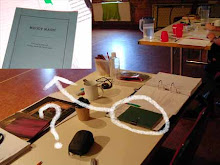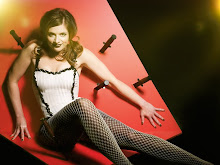This video was taken at the end of the day's work. It's the rehearsal room as it is set up now. Every day more things are added. I'll try to get down and have a look at how the set building is going for tomorrow. And the costumes too. The action down there seems to be building every day!
The cast run the play up to where we're at in the morning session. The first act is really exciting; there's a lot of buzz during the break between the first and second acts. Chris says afterwards that the first act is more advanced than he was imagining it would be at this point. It definitely has its own growth momentum now. There's details and 'special bits' to add, but it feels as though it has a beating heart now, which will pump blood through its whole.
The second act is about where Chris thought it would be, which is still rough. Given that they haven't quite finished rehearsing it, it's not a surprise. Even so, there's a palpable disappointment that the partial run hasn't quite brought together some of the threads that are proving illusive.
After lunch they sit down to de-brief. The things Chris talks about most are the big arcs, and the meaning of some of the important moments. One of the things the actors ask about is what Chris sees as the climax of the act. Because of the unusual structure they are unclear which moment is the climactic moment they are driving toward. This 'drive' is all important at this stage, the cast us unclear on it. What are the hierarchy of moments? What is the shape of the characters' individual journeys? The run has offered some insight and clarity to these questions that the cast share, but there is still a way to go.
One of the continuing lines of discusion surrounds what things in the play are part of an ongoing repeated cycle, and what things are happening for the first time. Trying to tease these questions out feels a bit like de-constructing an Escher painting. Defining a single moment one way or another often only creates logical conundrums for other moments in the play. Chris carefully offers definitive answers for some of the moments, and not for others.
The de-brief has been a good one. They've answered the questions they can and it's time to zoom back in again to the small picture. After the discussion they get down to work on the moments of the second act they've not yet covered. There's a strong desire to solve single moments again. For the second time this week the final scenes of the day involve Matt's character and one other. It's coincidence, but I wonder whether there is something useful about working with a speechless character at the end of the day. The scenes are necessarily more about physical action, and naturally eschew logical discussion about the text; good scenes to do when people are tired at the end of the day.
As promised, I caught up with Christen O'Leary to ask her about her process of working with the ventriloquist dummy. Christen's 'bodied' character is Maude, and her dummy is Doris.
She tells me that she had never done any ventriloquism before, and that she's never really been that interested in it. Having spent a couple of weeks with the dummy now, she's totally in awe of ventriloquists. It's an extraordinary skill that she feels might be a little under-rated. She makes the point that there is a magician on the show to train up the cast members doing magic tricks, but nobody thought there should be any such requirement for ventriloquism. (I believe it was thought that Christen's character is not necessarily an especially good ventriloquist. Nevertheless, it's a point well made.)
I ask her what is in her mind as she performs with the dummy. She says there are two things which are both surprisingly difficult. Firstly, not showing that you're talking. (Much more difficult than it seems, especially when you have to sing.) Secondly, she is acting a second character that is fully fledged and absolutely endowed with humanity.
This is interesting because I was presuming that the 'dummy' character is primarily speaking her 'bodied' character's sub-text. So why the need to approach the dummy as an entire character in and of itself. Why not approach the role as a single character? She agrees that the dummy mostly speaks the subtext, but says that she can't play it that way. The ventriloquism doesn't work unless the dummy can respond and interact like a 'real' person. The dummy must have its own life to be theatrically interesting.
Further, she feels that Maude is in denial of Doris. Maude doesn't see Doris as her own subconscious or subtext. Doris comprises some parts of Maude that Maude can't bear to look at. Doris is Maude's survival mechanism, the denial that allows her to function. “Some things in life are horrific.” says Christen, “Sometimes our mind saves us by shutting those things down.”
Christen talks about Maude's honesty in speaking through Doris, “She's incredibly honest. She's true to all the bile, she doesn't hide the frustration, the bile, the anger. She throws it in everybody's face.” But, she insists, you can't play that. She has to play Doris like she's her own character.
I ask her about the dummy's movement; the eyes, the mouth, the body. When they rehearsed this the detail they worked on in respect of the dummy's movements and timing was absolutely precise. Christen says that it's like working on two separate, distinct, simultaneous choreographies. Even for dancers that's a difficult job.
It occurred to me that we rarely work at this level of detail with 'real' bodies, and that perhaps we should. I put this to Christen. Her reply was that, for her personally, working in that way would be hell. She already feels that she builds this level of detail into her characters naturally. To do it formally would take large amounts of time, and would probably undermine the natural process that takes place irrespective. You can rely on a good process building this level of detail and refinement without trying to tackle it directly.
I finally ask her what is the most difficult thing about the performance. She replies that it is her 'act' in the play within the play. She says that 'big comedy' is really hard for her. She doesn't like delivering the big comic lines. The “walking wound” type of character is where she feels most comfortable as a performer. Given her strong background in comedy, this came as something of a surprise. Having said that, a number a years ago she played a burn victim in a full 'burns' recovery suit; her performance in that play has stayed with me for years.
Subscribe to:
Post Comments (Atom)




No comments:
Post a Comment